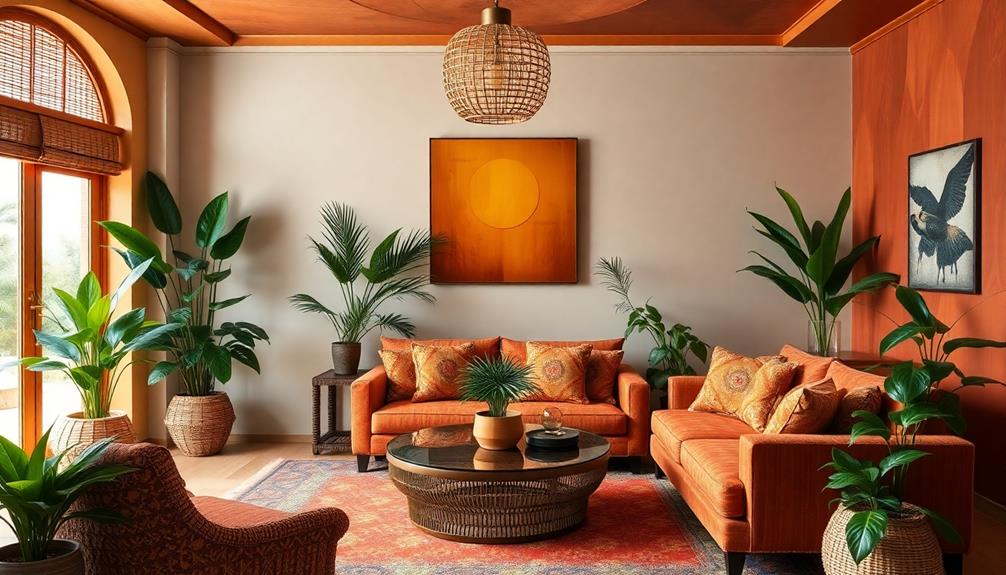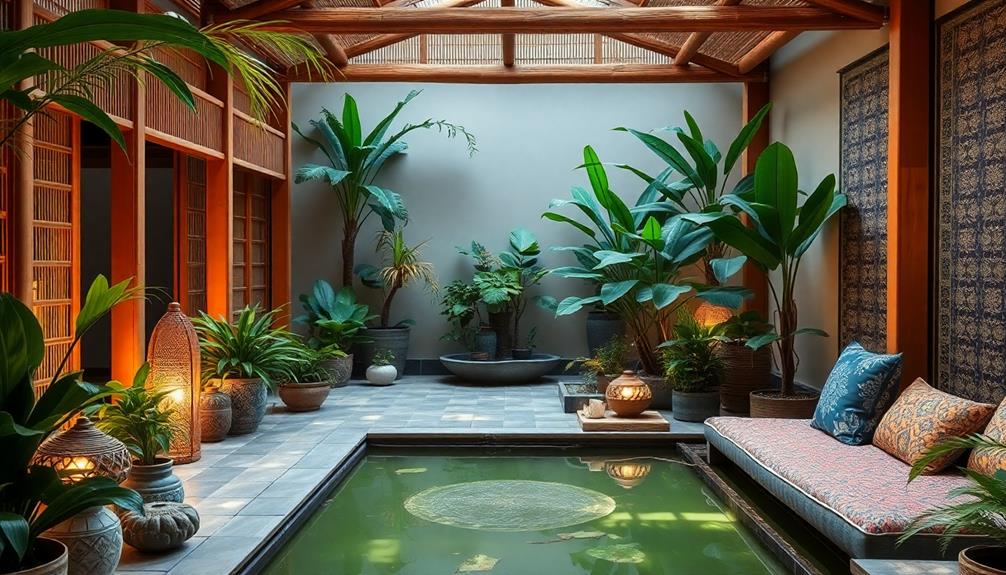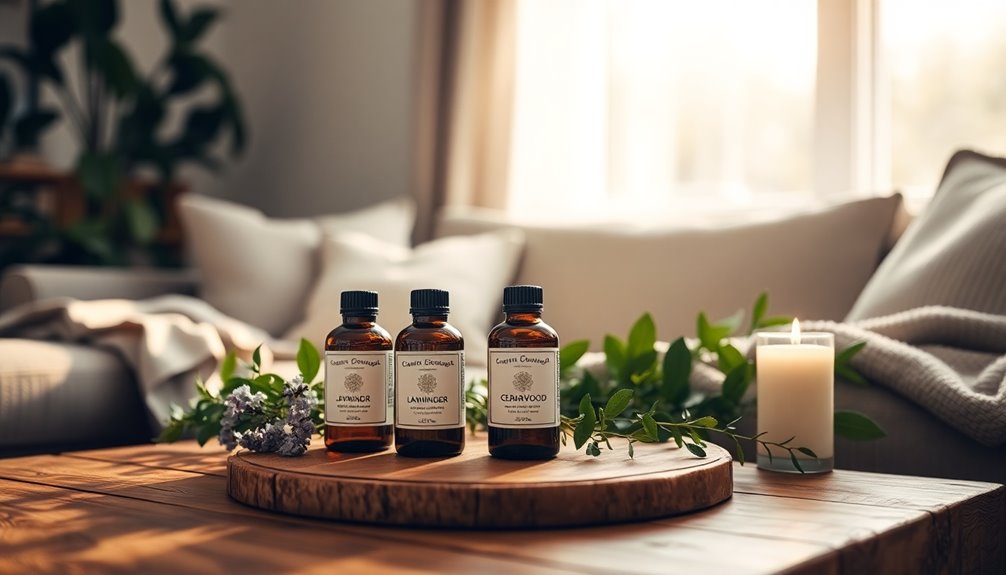Enhance your space with Indonesian home decor that reflects cultural charm! Embrace the vibrant colors of Balinese style, using natural materials like teak and rattan for warmth. Incorporate wooden sculptures and traditional textiles to add depth and storytelling elements. Mix modern designs with intricate craftsmanship for a unique flair. Create tranquility with earthy tones and indoor plants, while water features foster serenity. Don’t forget to highlight local artwork to support artisans and enrich your environment. Discover even more ideas to make your home a cultural haven that resonates with peace and authenticity!
Key Takeaways
- Incorporate vibrant batik textiles and ikat patterns to add depth and cultural significance to your decor.
- Use handcrafted Balinese wooden furniture as focal points to showcase unique craftsmanship and heritage.
- Enhance your space with spiritual elements, like wooden sculptures and water features, for tranquility and mindfulness.
- Create a seamless indoor-outdoor flow with traditional wooden decking and tropical greenery to promote relaxation.
- Blend modern aesthetics with traditional motifs to craft a unique and culturally rich environment.
History of Indonesian Home Decor

Have you ever wondered how the rich tapestry of Indonesian home decor evolved? Traditional Indonesian decor is a beautiful fusion of diverse cultural influences, shaped by a history that intertwines Hindu-Buddhist traditions, indigenous practices, and European colonial designs.
Homes, or "rumah adat," often feature elevated structures made from natural materials like bamboo and wood, designed to blend harmoniously with their surroundings. The use of Indonesian decorative pillows adds vibrant colors and intricate patterns, enhancing the overall aesthetic while reflecting cultural heritage.
The intricate carvings and textiles found in these homes reflect regional variations, showcasing local myths and spiritual beliefs. For example, areas like Bali and Java are renowned for their craftsmanship, where traditional elements come alive through art.
With the arrival of Dutch colonization in the 19th century, Western architectural styles began to influence Indonesian homes, creating a unique blend of local and European aesthetics.
As we moved into the 20th century, increased tourism and globalization brought Indonesian decor into the global spotlight. This exposure led to modern adaptations that still honor traditional designs and cultural significance.
Understanding this history not only enriches your appreciation for Indonesian decor but also inspires you to incorporate these timeless elements into your own space.
Key Characteristics of Balinese Style

When you think of Balinese style, imagine a vibrant color palette paired with natural materials like teak and mahogany.
This decor not only highlights intricate patterns but also integrates spiritual symbols that bring a sense of peace and purpose to your space.
By embracing these key characteristics, you can create an inviting atmosphere that reflects the island's rich culture and encourages indoor-outdoor living through seamless shifts and natural ventilation.
The emphasis on minimalism and soothing color schemes further enhances the tranquil ambiance of your home.
Natural Materials Emphasis
Balinese style invites you to embrace the beauty of natural materials, creating a warm and inviting atmosphere in your home. By focusing on organic elements, you foster a connection with nature and promote tranquility.
This design approach not only reflects local culture but also emphasizes harmony with the surrounding environment, enhancing your overall living experience. Here are three key aspects to contemplate:
- Natural Materials: Use bamboo, rattan, and volcanic stone in your decor. These durable materials not only enhance aesthetics but also provide a sense of grounding and stability, as seen in traditional Indonesian style home decor.
- Intricate Carvings: Incorporate furniture made from teak and mahogany, showcasing detailed carvings that reflect local myths and cultural heritage. These pieces tell a story while adding depth and character to your space.
- Water Features: Integrate calming water elements, like fountains or ponds, alongside stone sculptures. These features create a serene ambiance, promoting relaxation and harmony in your home.
Additionally, traditional textiles like ikat and batik add vibrant colors and patterns, celebrating the rich cultural legacy of Bali.
When you combine earthy tones with these elements, your space will radiate the enchanting essence of Balinese style, making it a true haven of peace and beauty. Incorporating natural textures like woven rattan, bamboo, and stone further enhances the serene ambiance, creating a seamless connection between indoor and outdoor living. To elevate the exotic appeal, you could also consider blending Egyptian style home decor, which introduces elegant motifs and intricate patterns that harmonize beautifully with the simplicity of Balinese design. The fusion of these rich cultural influences will create a truly unique and tranquil retreat.
Vibrant Color Palette
The vibrant color palette in Balinese decor creates an atmosphere that resonates with the beauty of nature and elevates your living space. By integrating earthy tones like browns and greens with bold hues such as deep reds, bright yellows, and rich blues, you can embody the essence of Bali in your home. Traditional textiles like ikat and batik play an essential role, adding depth and character to your interiors.
| Color Type | Characteristics |
|---|---|
| Earthy Tones | Reflects natural surroundings |
| Bold Hues | Adds vibrancy and energy |
| Traditional Textiles | Rich patterns and cultural heritage |
| Natural Dyes | Derived from plants and minerals |
| Balancing Atmosphere | Promotes harmony and tranquility |
Incorporating these vibrant colors not only enhances your mood but also creates a lively, inviting space. The careful selection of shades that symbolize water, earth, and fire brings a balanced atmosphere, allowing you to connect with your surroundings. Embrace the rich cultural heritage of Balinese decor, and watch your home transform into a vibrant sanctuary.
Spiritual Symbol Integration
Integrating spiritual symbols into your home decor can profoundly enhance the essence of Balinese style. This unique approach not only brings beauty but also infuses your space with cultural significance. Incorporating traditional artistry of masks can also add an authentic touch, reflecting the rich heritage of Indonesia.
Here are three ways to incorporate these elements:
- Intricate Carvings: Utilize wooden sculptures that depict Hindu deities or mythological figures, reflecting Balinese culture and spirituality. These pieces can be focal points in your living area.
- Traditional Masks: Hang traditional masks on your walls. They serve as striking decor while embodying rich spiritual narratives and artistic legacies. Each mask tells a story, connecting you to the island's heritage.
- Water Features: Add water features like fountains or ponds to your home. These symbolize purity and tranquility, creating a peaceful atmosphere that invites relaxation and harmony.
Pair these elements with nature-inspired colors, such as earthy tones and vibrant textiles, to create a serene environment.
Blending Tradition With Modern Design

Blending tradition with modern design creates a harmonious space that celebrates cultural heritage while embracing contemporary aesthetics. When you incorporate Indonesian home decor style, you're not just adding elements to your space; you're telling a story rich in tradition.
Consider adding a striking Indonesian decor mask as a focal point, which represents the rich Indonesian cultural heritage and enhances the overall aesthetic. Use traditional craftsmanship, like intricate wood carvings and textiles, alongside minimalist modern design to achieve a unique aesthetic.
Consider using natural materials such as bamboo and rattan for furniture, which provide an organic feel that promotes warmth and comfort in your interior design. You can also integrate traditional Indonesian patterns, like batik and ikat, through textiles or wall art. This adds vibrant colors and cultural significance to your contemporary settings.
Incorporating handcrafted pieces not only emphasizes clean lines but also reflects the artistry of Indonesian culture.
Don't forget to add water features and greenery, common in traditional Balinese home decor, to enhance tranquility and create a seamless indoor-outdoor living experience. By thoughtfully blending these elements, you'll create a space that's both functional and artistically inspiring, making your home a true reflection of your appreciation for tradition and modernity.
Color Schemes and Textures

When it comes to color schemes, you'll find that nature-inspired palettes can create a soothing atmosphere in your home.
Incorporating the cultural storytelling aspect of Indonesian decor masks can further enhance this ambiance.
By mixing smooth and rough textures, like polished wood and woven fabrics, you can achieve a stunning contrast that adds depth.
Layering different patterns not only enhances visual interest but also brings a rich tactile experience to your space.
Nature-Inspired Color Palettes
Nature-inspired color palettes bring the beauty of the outdoors into your home, creating a soothing and inviting atmosphere. By incorporating earthy tones like rich browns, warm terracottas, and soft greens, you reflect Indonesia's lush landscapes and materials.
These colors not only ground your space but also evoke a sense of peace, reminiscent of the modern tropical aesthetics in Bali that seamlessly blend indoor and outdoor environments.
To enhance your design, consider these key elements:
- Vibrant Hues: Add pops of color inspired by traditional textiles like deep indigos from batik or vivid reds and yellows from ikat. These vibrant hues can create a striking balance with your earthy tones.
- Natural Textures: Use materials like bamboo, rattan, and handcrafted wood. These natural textures provide visual interest and a tactile connection to nature, enriching your decor.
- Calming Water Features: Incorporate small indoor fountains to promote tranquility. The sound of water enhances the calming effect of your nature-inspired color schemes, making your space feel more serene.
Textural Contrast Techniques
Explore the enchanting world of textural contrast techniques to elevate your home decor. By pairing natural materials like bamboo and rattan with sleek, modern finishes, you create visual interest and depth in your space. This approach highlights the craftsmanship behind traditional Indonesian decor while embracing contemporary design.
Consider incorporating pieces from luxury tropical design aesthetics that blend natural elements with modern luxury, further enriching your decor.
Choose a color palette featuring earthy tones, such as terracotta and deep greens, to set a warm and tranquil atmosphere. Incorporating vibrant accents from traditional Indonesian textiles can further enhance the aesthetic.
Layering textures, like soft woven fabrics against polished wooden surfaces, invites a dynamic feel, reflecting Indonesia's rich tactile heritage.
Consider contrasting materials, such as the roughness of volcanic stone paired with smooth ceramics. This not only emphasizes the cultural significance of each element but also adds sophistication to your decor.
Applying textural contrast techniques allows you to showcase the beauty of handcrafted Indonesian items while promoting harmony between traditional and modern styles.
Ultimately, by thoughtfully blending these elements, you can transform your home into a unique sanctuary that resonates with the charm of Indonesian culture.
Layering Patterns Effectively
Layering patterns effectively can transform your home decor into a visually engaging space. Start by choosing a dominant print, like traditional batik, and pair it with smaller, subtler patterns, such as stripes or dots. This method keeps your design cohesive while showcasing intricate details and cultural significance, reflecting the diverse styles found in traditional Indonesian housing.
To create a harmonious look, consider these three tips:
- Color Palette: Use earthy tones inspired by natural elements, such as terracotta and deep greens. This enhances the visual appeal of your layered patterns and maintains a serene atmosphere.
- Texture Mixing: Combine smooth fabrics like silk with rougher materials, such as woven rattan or jute. This contrast adds depth and interest to your decor.
- Scale Balance: Pair large-scale prints with smaller patterns to prevent a chaotic look. This balance helps create focal points without overwhelming your space.
Essential Furniture and Accessories

When it comes to essential furniture and accessories for your home decor, Indonesian pieces stand out for their unique craftsmanship and cultural significance. Balinese wooden furniture, often made from durable teak or mahogany, showcases intricate craftsmanship that reflects local myths and stories.
Consider investing in a beautifully carved coffee table or a stunning armoire to serve as focal points in your living space. To further enhance the ambiance, you might explore Indonesian wedding decor ideas that incorporate vibrant colors and natural elements.
To enhance the cultural tapestry of your home, incorporate accessories like traditional batik textiles and ikat patterns. These vibrant fabrics can be used for cushions, throws, or wall hangings, adding depth and color. Hand-carved wooden sculptures and masks not only elevate your decor but also pay homage to Indonesia's rich artistic heritage.
Don't forget the importance of natural materials in your design. Rattan furniture and bamboo accents create a warm, inviting atmosphere that complements the overall theme.
Additionally, integrating water features, such as small fountains or aquariums, promotes tranquility and reflects the significance of nature in Indonesian design philosophy. By blending these essential elements, you'll create a harmonious and culturally rich space that truly embodies the spirit of Indonesia.
Creating Tranquil Indoor Spaces

Creating a tranquil indoor space starts with selecting the right furnishings and decor that evoke a sense of calm. To achieve a serene atmosphere, consider these design elements that highlight cultural richness and natural beauty:
- Handcrafted Indonesian Furniture: Choose pieces made from warm materials like teak and mahogany. They not only add character but also create a harmonious blend with your environment.
- Earthy Color Palette: Utilize colors inspired by nature, including soft browns and greens, along with vibrant traditional textiles like ikat and batik. This enhances the calming effect and ties in your cultural aesthetic.
- Spiritual and Natural Elements: Incorporate water features, stone sculptures, and indoor plants. These not only freshen the air but also foster mindfulness and tranquility within your home.
Outdoor Serenity and Garden Design

To achieve outdoor serenity, it's essential to blend natural elements with thoughtful design, transforming your garden into a peaceful retreat. You can start by incorporating traditional Indonesian wooden decking in your outdoor space, creating a seamless flow between nature and design. This enhances the tranquility of your garden, making it a perfect spot for relaxation.
Consider adding water features like ponds or fountains inspired by Balinese culture. These elements foster a serene atmosphere, promoting mindfulness as you unwind. Complement your design with handcrafted wooden furniture, such as benches and tables, which reflect Indonesian craftsmanship while inviting comfort.
Planting tropical greenery and vibrant flowers, like frangipani and hibiscus, infuses your space with life. Not only do these plants improve air quality, but they also add beautiful bursts of color, enhancing the overall aesthetic.
Here's a quick overview of key elements to include in your outdoor design:
| Element | Purpose | Benefits |
|---|---|---|
| Traditional Decking | Seamless flow with nature | Enhances tranquility |
| Water Features | Serenity and mindfulness | Promotes relaxation |
| Handcrafted Furniture | Functional art | Invites comfort |
| Tropical Greenery | Vibrant color | Improves air quality |
| Minimalist Design | Integrated beauty | Creates a peaceful sanctuary |
Frequently Asked Questions
What Are the Best Places to Buy Indonesian Home Decor Online?
You can find great Indonesian home decor online at sites like Etsy, Amazon, and local marketplaces. They offer unique pieces that reflect rich cultural heritage, so you're sure to discover something special for your space.
How Can I Care for Indonesian Wooden Furniture?
To care for Indonesian wooden furniture, clean it regularly, polish it often, and avoid direct sunlight. You'll maintain its beauty, protect its integrity, and guarantee it lasts for years, keeping its charm intact.
What Are Common Themes in Indonesian Home Decor?
In Indonesian home decor, you'll notice themes like natural materials, vibrant colors, intricate carvings, and traditional patterns. These elements reflect the rich cultural heritage, creating a warm, inviting atmosphere that connects you to nature and craftsmanship. Indonesian home decor ideas often incorporate elements like rattan furniture, bamboo accents, and woven textiles, blending functionality with aesthetic appeal. The use of batik prints or ikat designs on cushions, curtains, or wall art adds an artistic touch that highlights Indonesia’s diverse craftsmanship. By emphasizing earth tones and organic materials, these interiors exude a sense of tranquility and rootedness in nature.
Are Indonesian Textiles Suitable for Outdoor Use?
Yes, Indonesian textiles can be suitable for outdoor use, but it depends on the specific fabric. You should look for weather-resistant materials to guarantee durability, so your outdoor space remains stylish and functional.
How Do I Incorporate Indonesian Decor in a Small Space?
You might think small spaces can't handle bold decor, but that's where Indonesian charm shines! Use vibrant textiles, small sculptures, and wall hangings to create a cozy, inviting atmosphere that maximizes style without overwhelming your space.
Conclusion
Incorporating Indonesian home decor can truly transform your space into a vibrant oasis of culture and charm. Did you know that 90% of Balinese homes emphasize harmony with nature through open layouts and natural materials? By blending traditional elements with modern design, you create a serene environment that reflects both your personality and the rich heritage of Indonesia. So go ahead, embrace these unique ideas, and let your home tell a story of cultural beauty and tranquility!









